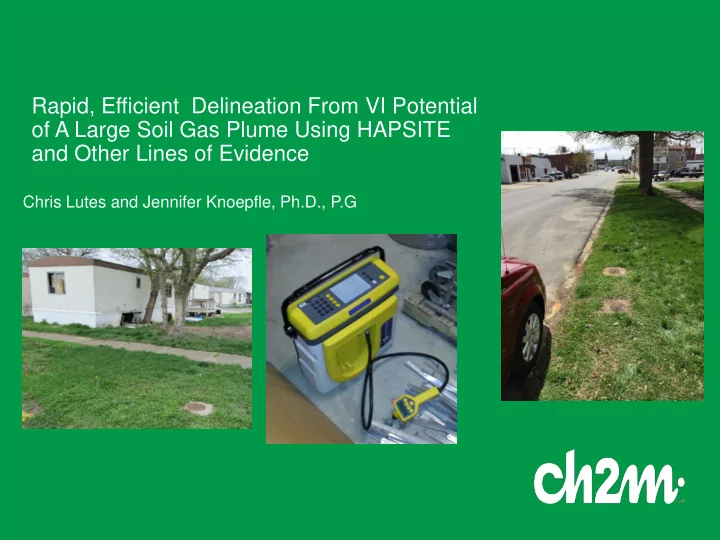

Rapid, Efficient Delineation From VI Potential of A Large Soil Gas Plume Using HAPSITE and Other Lines of Evidence Chris Lutes and Jennifer Knoepfle, Ph.D., P.G
Site Setting • Small town in Indiana; EPA led NPL Site • Residential and Commercial (pop. = ~5,000) • Unconsolidated sand and gravel aquifer (0-~90 ft bgs) overlies shale bedrock • Municipal water extracts (~10-20 µg/L) (drawn from entire aquifer 15 – 90 ft bgs) exceed the MCL (5 µ g/L) for PCE • Five of 36 monitoring wells screened over the “shallow” aquifer (5-23 ft bgs) have PCE concentrations in groundwater greater than the residential VISL (~26 µg/L) (14% of wells exceed) • Permanent soil vapor probes (SVP) installed to a depth of one foot above the top of water table. Top of water table ranged from 8 to 12 bgs. A total of 15 of 18 SVPs have PCE concentrations that exceed the residential subslab VISL (~360 µ g/m3). (83% of SVPs exceed) • Some residents still use private wells screened in the shallow aquifer 2 Presentation Title
Basic History • 1986-1991: Industrial dry cleaner (source) was operational (PCE contamination) • 2003 – 2008: EPA removal action (soil excavation + AS-SVE in and adjacent to source) • 2010: IDEM noticed PCE impacted municipal wells exceed PCE MCL and town treats water through carbon filtration • 2015: Region/CH2M began RI efforts (4 field events) • 2016: Subslab and Indoor Air Sampling Underway by EPA 3 Presentation Title
Recent Investigation Approach • August 2015: PCE (and TCE) soil vapor plume – 15 of 18 permanent SVP exceeded the PCE VISL • Five locations exceeding the IDEM action levels and EPA Removal Management Levels (RMLs) for PCE (2 locations for TCE) – Soil Vapor Max concentrations 170,000 µ g/m3 (PCE) and 12,000 (TCE) • August 2015: Bulk soil concentrations (discrete depth) for PCE and TCE exceeded residential RSLs in one permanent SVP location. Soil considered delineated. • October 2015: PCE “residual” groundwater plume – considered delineated (120 µ g/L= max GW PCE concentration) 4 Presentation Title
December 2015: HAPSITE soil vapor investigation • 80 soil gas locations around the site, to delineate the extent of the soil vapor plume and guide EPA Emergency Response (size, shape, chemical nature of plume); • 80 points completed in 5 days; 8 ft depth (42% exceeded VISL). Project included 8 confirmatory lab samples • 2016 Removal branch/START has recently performed targeted subslab and indoor air sampling (results pending) • May 2016: 2 nd HAPSITE soil gas investigation is proposed based on results from December 2015 to complete soil vapor delineation 5 Presentation Title
Comparison of Effected GW/Soil Vapor Plume Dimensions •Plume based on locations were GW PCE concentrations exceeded VISLs – ~9 buildings – ~164,000 ft 2 (two small plumes 60,000 ft 2 and 104,000 ft 2 each) – ~3.9 acres (two small plumes 2.4 acres and 1.4 acres each) •Plume based on results from results from permanent soil gas points – ~18 buildings – ~585,000 ft 2 plume area – ~13.4 acres •Plume based on results from First HAPSITE investigation – ~178 buildings – ~3,796,900 ft 2 plume area – ~87.1 acres 6 Presentation Title
Plume Map Based on Groundwater VISL Exceedances 7 Presentation Title
HAPSITE Planned Locations –Based On Permanent Soil Gas Results 8 Presentation Title
HAPSITE Results Substantially Increases Soil Gas Footprint in Several Directions 9 Presentation Title
Temporary Soil Vapor Probe Installation and Sampling Set-Up 10 Presentation Title
HAPSITE Instrument 11 Presentation Title
Cost Comparison •Conventional Approach: 18 permanent soil vapor points installed to 9-12 ft. bgs; one round of laboratory analysis = $43K about $2,400 a point. •HAPSITE/TRIAD Approach: 78 temporary soil vapor points, installed to 8 ft bgs, with HAPSITE analysis on all, 8 confirmation samples $74K about $950 a point. •This comparison does not include the additional benefits of speed and eliminating unnecessary sample points with field decision making. 12 Presentation Title
HAPSITE Output 13 Presentation Title
Methods Inter-comparison (Eight samples) Comparision of HAPSITE to Confirmatory Laboratory Samples for PCE 1000 HAPSITE Result (ug/m3) 2 Points data 100 Ideal Agreement VISL (PCE) VISL (PCE) 10 1 1 10 100 1000 10000 Laboratory Result (ug/m3) 14 Presentation Title
Lessons Learned •HAPSITE provided efficient delineation consistent with TRIAD principles of field adaptive decision making. •HAPSITE with temporary soil vapor probe mobilization was rapid – 2 months for planning and mobilization. •External soil gas sampling with HAPSITE allowed a greater density of data points then the permanent monitoring well network. •Soil gas points appear to exceed corresponding VISLs by greater ratio then shallow groundwater. Soil gas has higher percentage of exceedances and larger plume footprint mapped. 15 Presentation Title
Recommend
More recommend